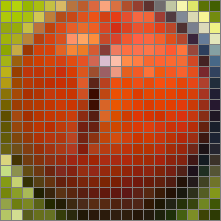| Copyright | (c) Alexey Kuleshevich 2016 |
|---|---|
| License | BSD3 |
| Maintainer | Alexey Kuleshevich <lehins@yandex.ru> |
| Stability | experimental |
| Portability | non-portable |
| Safe Haskell | None |
| Language | Haskell2010 |
Graphics.Image.Processing
Description
- downsampleRows :: Array arr cs e => Image arr cs e -> Image arr cs e
- downsampleCols :: Array arr cs e => Image arr cs e -> Image arr cs e
- downsample :: Array arr cs e => Image arr cs e -> Image arr cs e
- upsampleRows :: Array arr cs e => Image arr cs e -> Image arr cs e
- upsampleCols :: Array arr cs e => Image arr cs e -> Image arr cs e
- upsample :: Array arr cs e => Image arr cs e -> Image arr cs e
- leftToRight :: Array arr cs e => Image arr cs e -> Image arr cs e -> Image arr cs e
- topToBottom :: Array arr cs e => Image arr cs e -> Image arr cs e -> Image arr cs e
- crop :: Array arr cs e => (Int, Int) -> (Int, Int) -> Image arr cs e -> Image arr cs e
- flipV :: Array arr cs e => Image arr cs e -> Image arr cs e
- flipH :: Array arr cs e => Image arr cs e -> Image arr cs e
- rotate90 :: Array arr cs e => Image arr cs e -> Image arr cs e
- rotate180 :: Array arr cs e => Image arr cs e -> Image arr cs e
- rotate270 :: Array arr cs e => Image arr cs e -> Image arr cs e
- rotate :: (Array arr cs e, Elevator e, Interpolation method) => method (Pixel cs e) -> Double -> Image arr cs e -> Image arr cs e
- resize :: (Interpolation method, Array arr cs e, Elevator e) => method (Pixel cs e) -> (Int, Int) -> Image arr cs e -> Image arr cs e
- scale :: (Interpolation method, Array arr cs e, Elevator e) => method (Pixel cs e) -> (Double, Double) -> Image arr cs e -> Image arr cs e
- class Interpolation method where
- data Nearest px = Nearest !(Border px)
- data Bilinear px = Bilinear !(Border px)
- convolve :: ManifestArray arr cs e => Border (Pixel cs e) -> Image arr cs e -> Image arr cs e -> Image arr cs e
- convolveRows :: ManifestArray arr cs e => Border (Pixel cs e) -> [Pixel cs e] -> Image arr cs e -> Image arr cs e
- convolveCols :: ManifestArray arr cs e => Border (Pixel cs e) -> [Pixel cs e] -> Image arr cs e -> Image arr cs e
- data Border px
- pixelGrid :: (Array arr cs e, Elevator e) => Word8 -> Image arr cs e -> Image arr cs e
Geometric
Sampling
downsampleRows :: Array arr cs e => Image arr cs e -> Image arr cs e Source #
Downsample an image by discarding every odd row.
downsampleCols :: Array arr cs e => Image arr cs e -> Image arr cs e Source #
Downsample an image by discarding every odd column.
downsample :: Array arr cs e => Image arr cs e -> Image arr cs e Source #
Downsample an image by discarding every odd row and column.
upsampleRows :: Array arr cs e => Image arr cs e -> Image arr cs e Source #
Upsample an image by inserting a row of back pixels after each row of a source image.
upsampleCols :: Array arr cs e => Image arr cs e -> Image arr cs e Source #
Upsample an image by inserting a column of back pixels after each column of a source image.
upsample :: Array arr cs e => Image arr cs e -> Image arr cs e Source #
Upsample an image by inserting a row and a column of back pixels after each row and a column of a source image.
Concatenation
leftToRight :: Array arr cs e => Image arr cs e -> Image arr cs e -> Image arr cs e Source #
Concatenate two images together into one. Both input images must have the same number of rows.
topToBottom :: Array arr cs e => Image arr cs e -> Image arr cs e -> Image arr cs e Source #
Concatenate two images together into one. Both input images must have the same number of columns.
Canvas
Arguments
| :: Array arr cs e | |
| => (Int, Int) |
|
| -> (Int, Int) |
|
| -> Image arr cs e | Source image. |
| -> Image arr cs e |
Crop an image, i.e. retrieves a sub-image image with m rows and n
columns. Make sure (m + i, n + j) is not greater than dimensions of a
source image.
Flipping
flipV :: Array arr cs e => Image arr cs e -> Image arr cs e Source #
Flip an image vertically.
>>>frog <- readImageRGB "images/frog.jpg">>>writeImage "images/frog_flipV.jpg" $ flipV frog

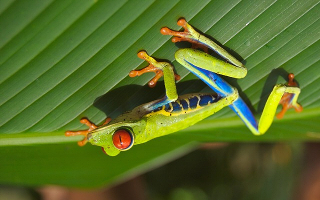
flipH :: Array arr cs e => Image arr cs e -> Image arr cs e Source #
Flip an image horizontally.
>>>frog <- readImageRGB "images/frog.jpg">>>writeImage "images/frog_flipH.jpg" $ flipH frog

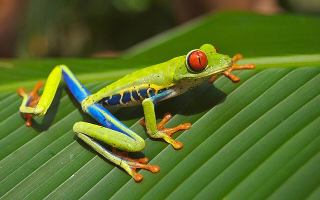
Rotation
rotate90 :: Array arr cs e => Image arr cs e -> Image arr cs e Source #
Rotate an image clockwise by 90°.
>>>frog <- readImageRGB "images/frog.jpg">>>writeImage "images/frog_rotate90.jpg" $ rotate90 frog

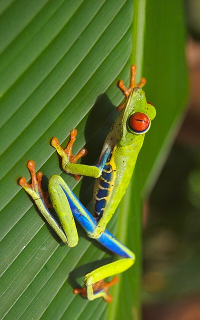
rotate180 :: Array arr cs e => Image arr cs e -> Image arr cs e Source #
Rotate an image by 180°.
>>>frog <- readImageRGB "images/frog.jpg">>>writeImage "images/frog_rotate180.jpg" $ rotate180 frog

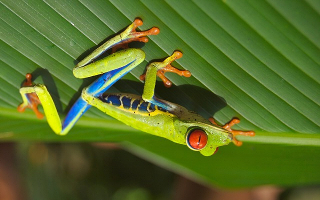
rotate270 :: Array arr cs e => Image arr cs e -> Image arr cs e Source #
Rotate an image clockwise by 270°.
>>>frog <- readImageRGB "images/frog.jpg">>>writeImage "images/frog_rotate270.jpg" $ rotate270 frog

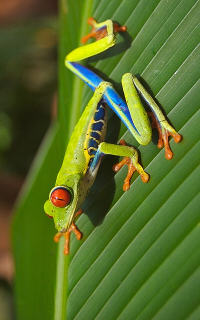
Arguments
| :: (Array arr cs e, Elevator e, Interpolation method) | |
| => method (Pixel cs e) | Interpolation method to be used |
| -> Double | Angle in radians |
| -> Image arr cs e | Source image |
| -> Image arr cs e | Rotated image |
Rotate an image clockwise by an angle Θ in radians.
>>>frog <- readImageRGBA "images/frog.jpg">>>writeImage "images/frog_rotate330.png" $ rotate (Bilinear (Fill 0)) (11*pi/6) frog


Scaling
Arguments
| :: (Interpolation method, Array arr cs e, Elevator e) | |
| => method (Pixel cs e) | Interpolation method to be used during scaling. |
| -> (Int, Int) | Dimensions of a result image. |
| -> Image arr cs e | Source image. |
| -> Image arr cs e | Result image. |
Resize an image using an interpolation method.
>>>frog <- readImageRGB "images/frog.jpg">>>writeImage "images/frog_resize.jpg" $ resize (Bilinear Edge) (100, 640) frog

Interpolation
class Interpolation method where Source #
Implementation for an interpolation method.
Minimal complete definition
Methods
interpolate :: (Elevator e, Num e, ColorSpace cs) => method (Pixel cs e) -> (Int, Int) -> ((Int, Int) -> Pixel cs e) -> (Double, Double) -> Pixel cs e Source #
Construct a new pixel by using information from neighboring pixels.
Instances
Nearest Neighbor interpolation method.
Instances
Bilinear interpolation method.
Instances
Convolution
Arguments
| :: ManifestArray arr cs e | |
| => Border (Pixel cs e) | Approach to be used near the borders. |
| -> Image arr cs e | Kernel image. |
| -> Image arr cs e | Source image. |
| -> Image arr cs e |
Convolution of an image using a kernel. Border resolution technique is required.
Example using Sobel operator:
>>>frog <- readImageY "frog.jpg">>>let frogX = convolve Edge (fromLists [[-1, 0, 1], [-2, 0, 2], [-1, 0, 1]]) frog>>>let frogY = convolve Edge (fromLists [[-1,-2,-1], [ 0, 0, 0], [ 1, 2, 1]]) frog>>>displayImage $ normalize $ sqrt (frogX ^ 2 + frogY ^ 2)
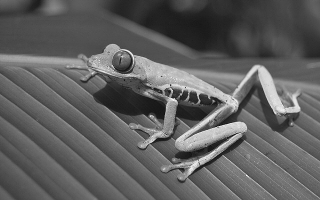
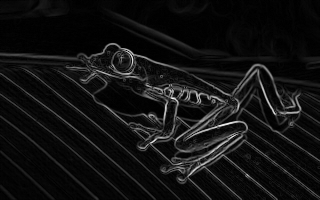
convolveRows :: ManifestArray arr cs e => Border (Pixel cs e) -> [Pixel cs e] -> Image arr cs e -> Image arr cs e Source #
Convolve image's rows with a vector kernel represented by a list of pixels.
convolveCols :: ManifestArray arr cs e => Border (Pixel cs e) -> [Pixel cs e] -> Image arr cs e -> Image arr cs e Source #
Convolve image's columns with a vector kernel represented by a list of pixels.
Tools
Approach to be used near the borders during various transformations. Whenever a function needs information not only about a pixel of interest, but also about it's neighbours, it will go out of bounds around the image edges, hence is this set of approaches that can be used in such situtation.
Constructors
| Fill !px | Fill in a constant pixel. outside | Image | outside
( |
| Wrap | Wrap around from the opposite border of the image. outside | Image | outside
|
| Edge | Replicate the pixel at the edge. outside | Image | outside
|
| Reflect | Mirror like reflection. outside | Image | outside
|
| Continue | Also mirror like reflection, but without repeating the edge pixel. outside | Image | outside
|
Arguments
| :: (Array arr cs e, Elevator e) | |
| => Word8 | Magnification factor. |
| -> Image arr cs e | Source image. |
| -> Image arr cs e |
This function magnifies an image by a positive factor and draws a grid around the original pixels. It is here simply as useful inspection tool.
>>>frog <- readImageRGB "images/frog.jpg">>>writeImage "images/frog_eye_grid.png" $ pixelGrid 10 $ crop (51, 112) (20, 20) frog

